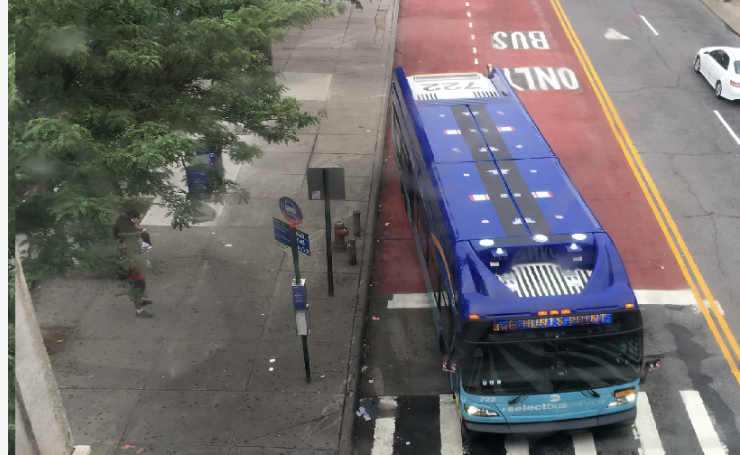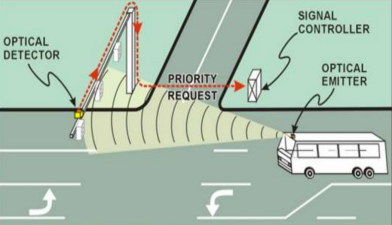SPEEDY! Mayor Takes Victory Lap On Hylan Boulevard Bus Lane*
* Though that's the lane he trimmed from 6.6 miles to 4.7 miles to appease car owners.

Build it and they will hum.
Mayor de Blasio, who has been under fire of late for not making good on the full extent of his June bus lane improvement promise, touted one clear success that he has accomplished: Buses on Hylan Boulevard in Staten Island are motoring along 71 percent faster during the afternoon rush period, compared to pre-COVID slogs.
Speeds are also up 28 percent during the morning rush in the northbound dedicated bus lane, compared to the pre-COVID-era average speed of 9.2 miles per hour. The improvements are saving the average ferry-bound commuter exactly two minutes and one second. Coming home, the 14.9 mph average afternoon rush hour speeds (up from 8.7 miles per hour in the pre-COVID era) would save the same commuter nearly nine minutes and 30 seconds.
Of course, that morning time savings could have been even better: The original Hylan project called for 6.6 miles of dedicated lanes, split evenly on the north and south sides of Hylan between Lincoln and Nelson avenues, but 1.9 miles were trimmed from the south (northbound) side of Hylan to comprise just 1.4 miles of dedicated bus lane between Lincoln and Guyon avenues. The dedicated lanes operate from 6 to 9 a.m. (northbound) and 3 to 7 p.m. (southbound) on weekdays.
The improvements are helping an estimated 33,000 daily riders on the S79 Select Bus Service, the S57 and S78 local routes, and eight express routes.
Staten Island Borough President issued a statement of support.
“Dedicated bus lanes on Staten Island such as these are needed to speed up what is already one of the lengthiest commutes in the country, and to get people out of their cars, government has to incentivize people to take mass transit,” he said.
The Staten Island bus announcement is the rare bit of good news for bus riders. The mayor announced 20 miles of busways and dedicated bus lanes in June, but the agency now says it will complete 17 miles of projects by the end of the year, adjusting for the Hylan cuts and the removal of Fifth Avenue from busway treatment.
To date, 9.1 miles of bus priority projects have been completed this year, including a completed car-free busway on Jay Street in Brooklyn, a bus lane extensions on 14th Street and dedicated bus lanes on 149th Street in The Bronx and Malcolm X Boulevard in Brooklyn. But several projects, such as the Main Street busway in Queens, have been delayed.
The projects are crucial, advocates said.
“Bus lanes are an effective tool for a more equitable economic recovery, helping to move many commuters who are getting back to work following the COVID-19 pandemic,” said Tri-State Transportation Campaign spokesman Liam Blank.
The improved speeds come as DOT Commissioner Polly Trottenberg openly admitted at a Council hearing on Tuesday that the current system for building bus lanes is broken.
“The model of the way we do bike lanes and bus lanes right now — I don’t think it is the best model,” she told the Transportation Committee. “This summer we tried to be a little creative about it and make the process a little more nimble. But as a city, we need to, working with you all and the community boards, come up with a more streamlined process.”
She admitted that internal planning processes slow down the work — “It has at times made the process very slow,” she admitted — but added that “community input … community boards and local stakeholders” also slow down the process.
In the end, she sort of threw up her hands: “I think no matter how we do it, we’ll always have critics who say we move too fast or not fast enough.”
There are, indeed.
“There are changes needed throughout the process, but the biggest missing piece is firm resolve and a clear message by the mayor that the city will implement functioning bike and bus priority networks regardless of carping about parking spaces,” said Jon Orcutt, a former city official who is now spokesman for Bike New York. “There are also parts of city government like the police and Sanitation that need to support street changes to make them effective, but who aren’t even remotely on board now. That, too, stems from neglect by the mayor.”
— with Dave Colon


